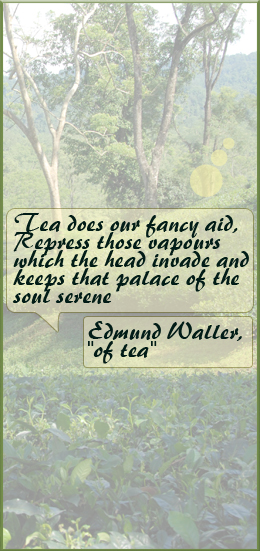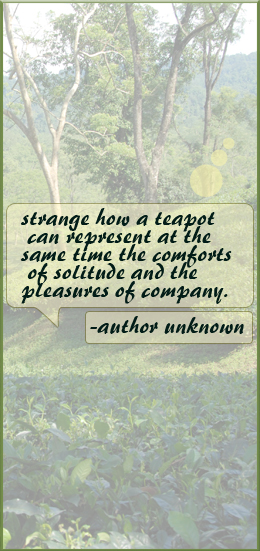



If the stranger say unto thee
That he thirsteth
Give him a cup of Tea
– Confucius
Tea, a refreshing drink from the plant Camellia Sinensis is the most consumed beverage in the world after water. Tea drinkers around the world have been enjoying tea for its refreshing flavour, its remarkable health properties and medicinal qualities. Today, there are more than 3000 varieties of tea having their own distinctive flavour and character but mainly there are four kinds of teas-Black, Green, Oolong and White.
All tea comes from the Camellia Sinensis bush, known as the Tea Plant. The leaves and buds of the tea plants are plucked several times per year, usually by hand. The different pickings are referred to as “flushes”, so you will notice that some teas are sold as “second flush” etc. to indicate when they were picked. The different flushes will have different flavour characteristics. Once picked, the tea can be processed into black tea, oolong tea, green tea or white tea.
Sometimes tea is sold by the estate, or the tea garden it originates from. The advantage of purchasing by estate is twofold. First, you know that if a tea is being sold pure and unblended, it is considered a high quality tea, and good enough to “stand on its own”. Second, different gardens will produce teas with different characteristics and reputations. Knowing the garden may make it easier for you to pick out a tea that you will enjoy. Keep in mind that some countries, such as China and Japan rarely sell by estate, but usually sell by type of tea- sencha, gunpowder etc.
There are four types of tea, namely, black, green, oolong and white tea. All kinds are made from the same plant species but undergo different methods of processing, and hence the different varieties.
Black tea is so called due to the several hours of fermentation that the leaf undergoes. The fresh leaves are spread to dry after plucking. Then the leaves are either rolled to make Orthodox Tea or passed through the “crush, tear, curl” process for CTC Tea and then fermented till coppery in colour. Finally, the teas are dried, graded and packed. India is the largest producer of Black Tea. Other regions include Sri Lanka, Kenya, Turkey etc.
These teas are not fermented at all but are steamed in large iron pans to soften the leaves, rolled and dried. China and Japan are the main producers of Green Tea.
Oolong Tea is semi-fermented. The manufacturing process is similar to black tea but the fermentation time is shorter. These teas are commonly produced in China and Taiwan.
White tea is unfermented and is produced from buds that are well hydrated. These teas are most commonly grown in China.
Tea does contain caffeine, though in much lower amounts than coffee. The amount of caffeine in tea would vary depending on the size of tea, variety and brewing time. It is a myth that green tea contains less caffeine than black tea. Generally, a 200ml cup of tea(6 ounce) would contain between 8mg to 110mg of caffeine. Black tea infused for 5 minutes would contain 40-100 mg of caffeine while 3-minute infusion would have around 20-40 milligrams. Very fine tea and tea bags produce an infusion of more caffeine than loose teas due to the small size of the leaves.
It is not possible to completely remove the caffeine from tea without losing its quality. But because caffeine is water soluble, most of the caffeine can be removed from the normal tea. To do this twice the amount of water to be consumed needs to be boiled. In the first step, the leaves should be infused for twenty to thirty seconds with the normal amount of water, thereafter which the infusion can be thrown away and the leaves retained. In the next step, the water should be boiled again and poured over these leaves, now infusing it normally for three to five minutes. This brew is the one to be drunk.
Antioxidants are properties found in some foods that can reduce your risk of getting cancer and heart disease. All tea is high in antioxidants, but there is still debate over whether certain teas contain more antioxidants than others. Some studies say that white tea contains the most, followed by green tea, and then black tea. Other studies say that the antioxidant benefits are similar between categories. Again, you can read about all the most recent antioxidant research at Canada.
Although herbal tea is prepared in a similar way to regular tea, it is not really “tea” at all. To truly be tea, the leaves must come from the Camillia Sinensis bush. Herbal teas usually contain herbs, fruits, spices, flowers or leaves from other plants, but no leaves from the true tea plant. As a result, herbal teas are more properly called infusions, or tisanes. Because herbal teas do not contain any tealeaves, they are nearly always caffeine free. Also, herbal teas do not necessarily have the same health benefits as regular tea.
Organic means that the tea was grown without the use of any artificial pesticides and herbicides, and that the estate has gone through a certification process to ensure you of this fact. Sometimes organic teas cost more than non-organic teas. The difference is in the flavour, but also due to the fact that organic crops are often smaller than non-organic crops, and because organic gardens have undergone more expenses to meet the certification requirements.
Tea should always be stored in air-tight, opaque containers such as metal tins, away from sunlight, water and other such factors in a cool and dry place. A dry spoon should be used to scoop out the tea, thereafter which the container should be closed tightly to retain the aroma and flavour of the tea. Tea should not be stored in refrigerators.
The primary difference between loose tea and tea bags is that loose tea is high-quality tea while tea bags contain broken leaves of very small size, sometimes dust, which is not of superior quality. Tea bags have a larger surface area and are therefore more exposed to external factors which may cause it to become stale and loose its flavour.
Assam teas have three seasons namely First Flush, Second Flush and Autumnal/Winter teas.
The first flush begins in March and lasts upto 8-10 weeks till May. The bushes of tea begin to grow at this time and the teas are light, rich, have a strong and fresh flavour and aroma.
Second Flush Assam teas are plucked from June to September and are renowned for their “tippy” teas (golden tips that appear on the leaves). These teas have a rich aroma, strong, creamy and malty taste and a dark red liquor.
This harvest takes place from October to December.
Darjeeling First Flush teas are picked in April and are among the finest of the teas fetching a very high price. These teas have a light liquor and a delicate flowery aroma and flavour.
Darjeeling Second Flush Teas are picked in May and June and are characterised by darker liquor, round, mellow, mature and muscatel flavour and plenty of silvery tips.
These teas are produced between mid-July to September and have a darker and more stronger liquor, a coppery gold brightness and sweet aroma and are ideal for breakfast blends.
These vintage Autumnal teas are picked during October and November and have a light coppery colour, delicate character, distinct and delightful flavour different from the First and Second Flush teas.